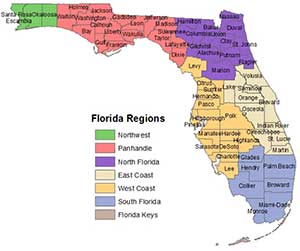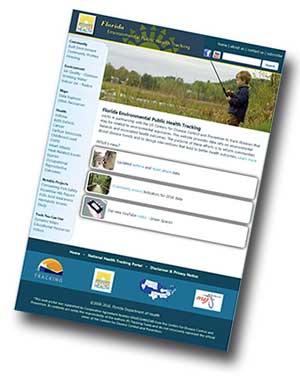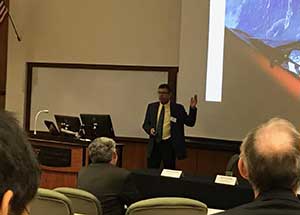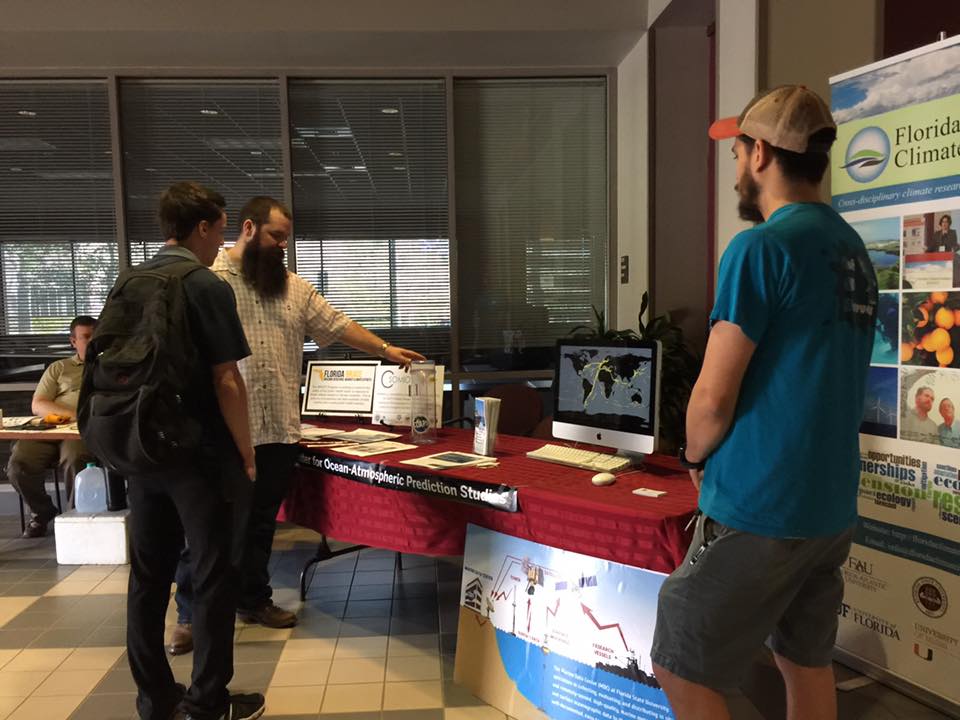A Newsletter for FL BRACE Partners, Collaborators & Stakeholders Spring 2018
|
|
|
WORKING TO IMPROVE THE HEAT ADVISORY AND
WARNINGS SYSTEM IN FLORIDA
Long, hot, and humid summers are a defining characteristic of Florida climate. At times, our high heat and humidity reaches extreme levels, putting a strain on human health and this sometimes manifests itself as illness and/or death in humans. FL BRACE, the Florida Department of Health, and the local offices of the National Weather Service that serve Florida have collaborated to improve preventative messaging about potential extreme-heat episodes.
 Historically, local offices of the National Weather Service took the lead in messaging about potential extreme-heat events. The messaging consisted of "Excessive Heat Advisories" and, in cases of extreme events, "Excessive Heat Warnings." These advisories and warnings relied on thresholds of air temperature and heat index, which takes account of both air temperature and relative humidity, being met for certain lengths of time. However, seven local offices serve Florida, and each local office had differing criteria for the issuance of advisories and warnings, leading to confusion. Moreover, there was concern that some local offices' criteria under-messaged for extreme heat, leading to situations in which an advisory or warning should have been issued but was not, and other offices' criteria over-messaged, leading to situations in which an advisory or warning was not justified. Historically, local offices of the National Weather Service took the lead in messaging about potential extreme-heat events. The messaging consisted of "Excessive Heat Advisories" and, in cases of extreme events, "Excessive Heat Warnings." These advisories and warnings relied on thresholds of air temperature and heat index, which takes account of both air temperature and relative humidity, being met for certain lengths of time. However, seven local offices serve Florida, and each local office had differing criteria for the issuance of advisories and warnings, leading to confusion. Moreover, there was concern that some local offices' criteria under-messaged for extreme heat, leading to situations in which an advisory or warning should have been issued but was not, and other offices' criteria over-messaged, leading to situations in which an advisory or warning was not justified.
|
|
 |
As temperatures climb throughout this month and the rest of summer, the Florida Department of Health encourages safe habits to prevent heat-related illness. They have developed materials to provide preventative messaging about extreme heat including their
Beat the Heat video (above).
|
 |
In the early 2010s, under an earlier BRACE grant, these perceived weaknesses led collaborators at the Florida Department of Health and the National Weather Service to develop new advisory and warning issuance criteria that were linked more directly to human health outcomes and that ideally would be more consistent across Florida. At county and municipal levels, they studied heat morbidity and mortality data collected by hospital emergency departments across the state. Their findings resulted in the implementation of new heat-index thresholds that would apply statewide, starting in 2012. Specifically, an excessive heat advisory is to be issued when the heat index exceeds 108°F over the majority of a forecast area, and an excessive heat warning is to be issued when the heat index exceeds 112°F over the majority of a forecast area. Moreover, Florida Department of Health developed pamphlets and videos to provide preventative messaging to the public about the perils of extreme heat.
Under the current FL BRACE grant, efforts involve evaluating the efficacy of these changes with respect to reducing human morbidity and mortality from extreme heat by means of development of an Integrated Monitoring Strategy that will serve the dual role of documenting the efforts of this collaboration. The Florida Department of Health continues its messaging efforts as well as its collection of human morbidity and mortality data through its Environmental Public Health Tracking (EPHT) Network (learn more about the EPHT program below).
For more information about this collaboration, contact Danny Brouillette.
|
|
Florida Environmental Public Health Tracking (EPHT) Program
A valuable resource for environmental hazard/health outcome data
 The
Florida Environmental Public Health Tracking (EPHT) program works in partnership with the US Centers for Disease Control and Prevention to track diseases that may be related to environmental exposures. The program website provides datasets on environmental hazards and associated health outcomes. The purpose of these efforts is to inform communities about disease trends and to design interventions that lead to better health outcomes.
Daniel Brouillette and Dr. Ava Holt from FL BRACE attended the April 2018 meeting of the program's Technical Advisory Group, along with many other environment-interested stakeholders from across the state of Florida. The meeting included presentations that: detailed program goals in relation to CDC, state, and local priorities; new functionalities of the web portal; ideas for new partnerships; and some working examples of how EPHT data have been effectively used in the last year. An interesting example was a NASA-funded project on extreme heat involving collaborators from Florida State University (including FL BRACE project lead Dr. Chris Uejio and doctoral student Jihoon Jung), the Florida Department of Health (including FL BRACE team member Kristina Kintziger), New York State Department of Health, New York City Department of Health, and the University of Alabama-Huntsville. The project used satellite and ground meteorological data to perform an epidemiological analysis of human mortality and morbidity from extreme heat in Florida and New York. The outcome of this analysis was vulnerability mapping and a look at decision support activities, particularly as relates to the issuance of alerts by the National Weather Service.
For more information about Florida's Environmental Health Tracking program, go to
https://www.floridatracking.com/healthtracking/about.htm
|
MAKING CONNECTIONS
 |
|
 |
Pictured (left to right): Volusia County environmental manager Suzanne Grubbs with FL BRACE's Tisha Holmes and Ava Holt
|
Earlier this month,
Drs. Tisha Holmes and
Ava Holt had the opportunity to visit with health officials in Volusia County and learn more about their "Beat the Heat" intervention project. Each year, Florida experiences annual temperatures that can reach levels that are harmful to human health. That is why, in 2016, the
Volusia County Health Department launched "Beat the Heat" -- an educational campaign designed to inform county residents about the health effects of extreme heat to help prevent heat-related illness or mortality.
 Florida's State Climatologist and co-PI on the FL BRACE project,
David Zierden of the
Florida Climate Center addressed attendees at the
UF Law Public Interest Environmental Conference. Each year, the conference brings together legal practitioners, academics, policy makers, and private citizens to discuss preeminent issues surrounding a different environmental topic each year. The theme of the 2018 conference was "Our Climate: The Only Constant is Change." Participants examined the challenges, concerns, and future of law, policy, and science related to climate change from a local, regional, and national standpoint.

Community events focused on science, such as the annual Innovation Park Open House held in Tallahassee, FL, are great opportunities to connect with and educate the general public. This year, FL BRACE was part of the FSU Center for Ocean-Atmospheric Prediction Studies (COAPS) information station at the Open House. Danny Brouillette spoke with hundreds of visitors over the course of the day about the connections between climate and health.
If you would like a member of the FL BRACE te
am to participate in or contribute to a community education or outreach event, please contact Tracy Ippolito.
|
FROM THE CDC
Climate Change and Extreme Heat: What You Can Do To Prepare
 |
|
 |
New booklet, published by the CDC and available online, identifies steps to prepare for an extreme heat event. |
Extreme heat events in the United States are already occurring and expected to become more common, more severe, and longer-lasting as our climate changes. The U.S. Environmental Protection Agency (EPA) and the Centers for Disease Control and Prevention (CDC) developed this booklet to identify steps that you can take now to prepare for an extreme heat event-and to help your families, friends, and neighbors, too.
This booklet answers some of the key questions about extreme heat in a changing climate: why extreme heat is on the rise, how it might affect you, and what you can do before and during an extreme heat event to reduce your health risk.
Scientific information used in this document is derived from peer-reviewed synthesis and assessment products, including those published by the United States Global Change Research Program and the Intergovernmental Panel on Climate Change, as well as other peer-reviewed sources and federal agency resources.
|
FL BRACE COMMUNITY ADVISORY GROUP (CAG)
Individuals and organizations in the community serving vulnerable populations
FL BRACE is working to create and strengthen relationships with agencies or organizations who serve vulnerable populations -- including, but not limited to, lower income households, social service organizations, churches, the homeless, older adults (age ≥ 65), and people with preexisting conditions. So if you or someone you know represents an agency or organization whose work with vulnerable populations would benefit from timely heath and climate information, please encourage them to join our Community Advisory Group (CAG).by contacting Ava Holt, FL BRACE.
|
|
|
FL BRACE CONTACTS
Dr. Chris Uejio (Principal/Lead Investigator), Department of Geology, Florida State University
Dr. Tisha Holmes, (co-PI) Department of Urban and Regional Planning, Florida State University
|
Danny Brouillette, Office of the State Climatologist
Dr. Ava Holt, Department of Urban and Regional Planning, FSU
Tracy Ippolito (Project Manager), FSU Center for Ocean-Atmospheric Prediction Studies
|
Dr. Kristina Kintziger, Department of Public Health, University of Tennessee Knoxville
Patrice Williams, Graduate Student, Department of Urban and Regional Planning, FSU
David Zierden, State of Florida Climatologist
|
STAY CONNECTED WITH FLORIDA BRACE


|
|
|
|
|